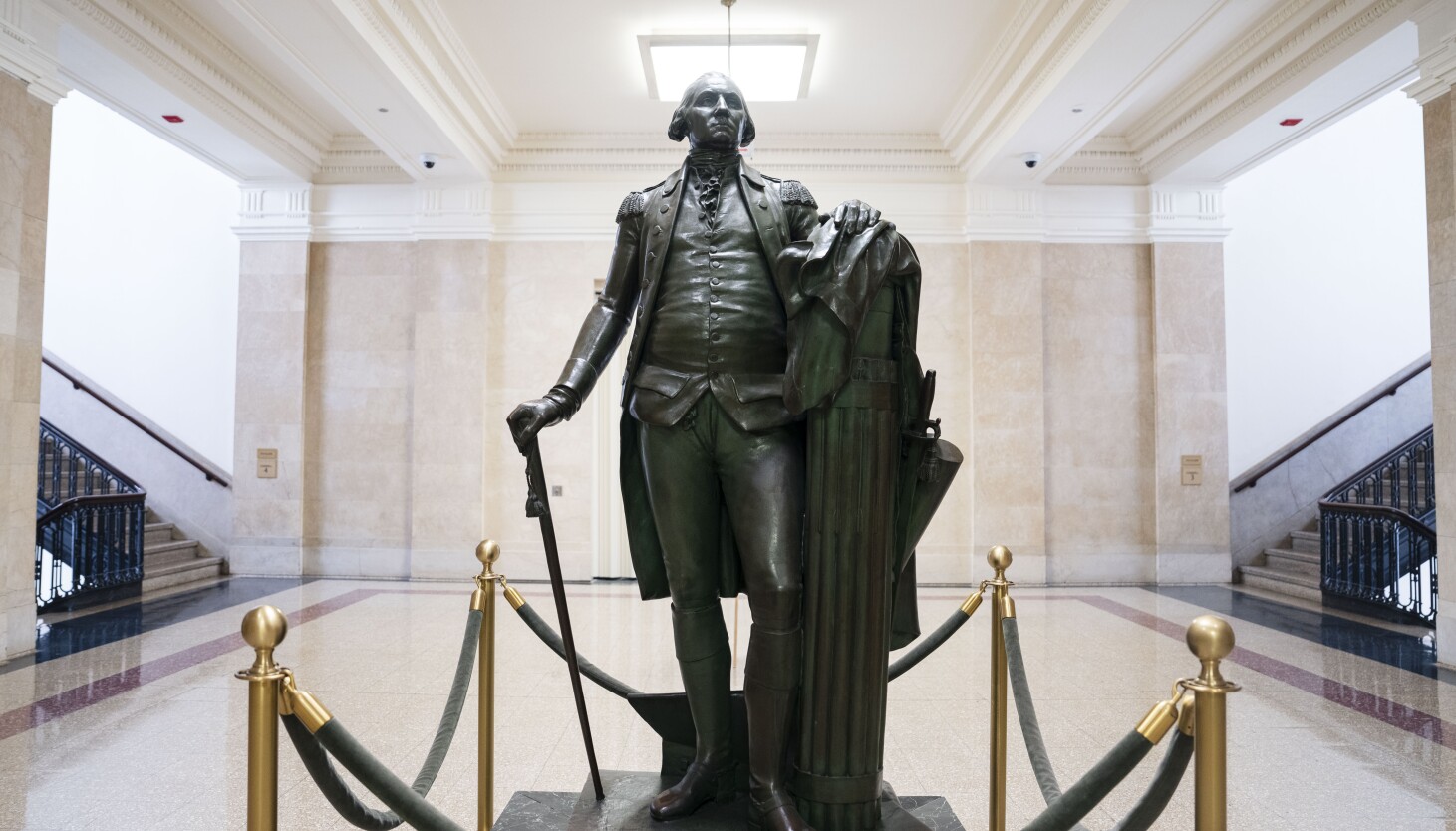Mayor Brandon Johnson plans to remove the statue of former President George Washington from the hallway outside the mayor’s office on the fifth floor of City Hall in a move that, a top aide said Tuesday, has nothing to do with the first president’s role as a slave owner.
Johnson’s Communications Director Ronnie Reese said the statue “is being removed from the hallway outside the mayor’s office as we make updates to some areas around City Hall.”
Reese said there is no timetable yet for the removal. He wouldn’t say if it would be moved to a new home, or put in storage. He also didn’t say what would replace it, or provide an estimate of the cost of all the changes.
According to the website maintained by Mount Vernon, Washington’s ancestral home, “317 men, women and children were enslaved at Mount Vernon’s five farms, which covered 8,000 acres.”
But Reese said the surprise removal is unrelated to Washington’s owning slaves.
“If people want to think that, I can’t stop them. But that’s not our intent,” Reese said.
“We’re just freshening up the space. Making it a bit more current. There’s a lot of Chicago icons who would be deserving of statues as well. We should be considering that also — Ida B. Wells, DuSable, Harold Washington.”
Reese advised the Sun-Times to contact Ald. Carlos Ramirez-Rosa (35th), the mayor’s former City Council floor leader and Zoning Committee chair, who has “some really good ideas” about “the usage of statues and monuments.”
“I know he has an idea of having, like a public area in which we could put monuments and make it kind of like an open space, like park space dedicated solely to monuments, which I think is actually a pretty decent idea,” Reese said of Ramirez-Rosa.
But reached for comment, Ramirez-Rosa didn’t want to talk about his ideas, and woudn’t say if he supports removing the Washington statue.
Ald. Nick Sposato (38th), Johnson’s hand-picked chair of the City Council’s Committee on Cultural Affairs and Special Events, was outraged by the planned move, just as he was when statues of Christopher Columbus were removed from their pedestals in Grant and Arrigo parks.
“When does this stop — the redoing everything and eliminating everything? I just don’t get it,” Sposato said.
“He’s George Washington. He risked everything. We are who we are because of this man. He could have just stood down and not get involved with the [Revolutionary] War and came here and lived a good life. But he fought for who we are. He should be honored all over the place. Next, are we gonna change the name of the streets” named for presidents, he said, mentioning Washington, Jefferson and Monroe streets specifically.
“When does it stop?”
According to the Mount Vernon website, Washington “accepted slavery without apparent concern” as a “young Virginia planter,” but “began to feel burdened by his personal entanglement with slavery and uneasy about slavery’s effect on the nation” after the Revolutionary War ended.
“When he drafted his will at age 67, Washington included a provision that would free the 123 enslaved people he owned outright,” the website states.
Sposato said that complicated history must be considered.
“ It’s hard to comprehend how a human being could treat another human being that way. But to discredit somebody’s legacy because they owned slaves back in the day” is unfair, Sposato said.
In July 2020, as Chicago reeled from civil unrest and looting after the murder of George Floyd, then-Mayor Lori Lightfoot ordered two Columbus statues “temporarily” removed .
At the same time, the mayor argued, statues of Columbus in Grant and Arrigo parks — statues vandalized repeatedly since Floyd’s killing — should not be torn down, but rather used to confront the nation’s history and trigger a long-overdue “reckoning.”
City Hall then launched the Chicago Monuments Project and created an advisory committee to review more than 500 Chicago statues and monuments .
The commission subsequently pinpointed 41 statues it deemed problematic, including statues of four presidents: George Washinton, Abraham Lincoln, Ulysses S. Grant and William McKinley. The targeted list included two statues of former President George Washington, but not the one in City Hall.
Lightfoot promised to return the Columbus statues to their pedestals in Grant Park, Arrigo Park, but never did. She left office without acting on the monuments commission’s recommendations.
Johnson has stopped short of calling for the monuments deemed racist by the commission to be removed, saying it would be up to the people of Chicago to “provide that direction.”
Nearly five weeks after taking office, Johnson announced plans to use a $6.8 million grant from the Mellon Foundation to build eight new public monuments, including a monument to the more than 100 Black men who were tortured by Chicago Police officers trained by former Area 2 Commander Jon Burge.
The Mellon Foundation grant was also expected to bankroll seven new monuments to recognize “events, people and groups that historically have been excluded or underrepresented,” according to a statement from the mayor’s office.
One of those new monuments, by Chicago artist Amanda Williams, would be called “The George Washington Monument Intervention.”
